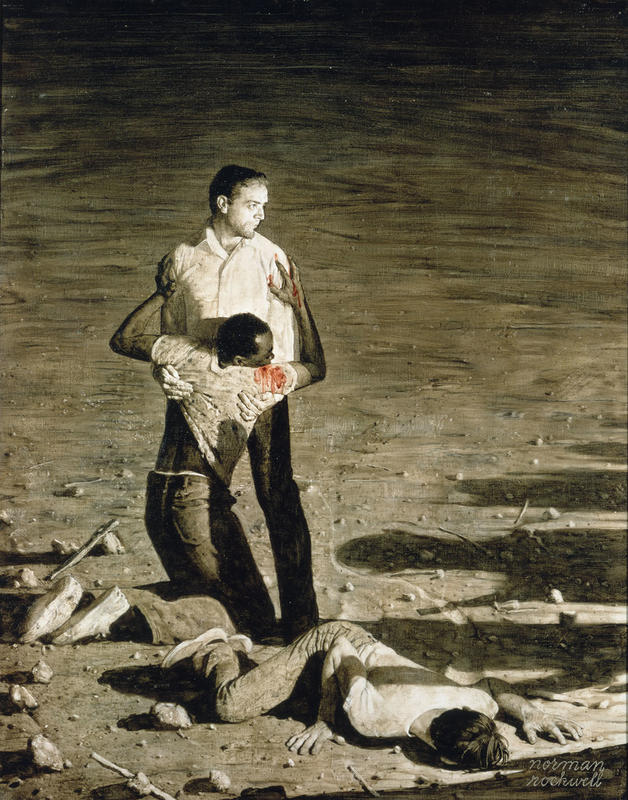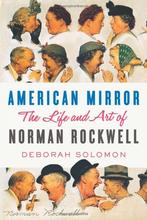More about Murder in Mississippi
- All
- Info
- Shop

Contributor
Known for his idyllic Mom-and-Pop style paintings, Norman Rockwell’s Murder In Mississippi caused quite a stir.
And “causing a stir” is kind of the last thing you’d expect from Rockwell. As America’s painting sweetheart— whose most famous works were of happy family dinners and posing presidential candidates— he wasn’t exactly considered cutting edge. But in the early 1960s, after dealing with four decades of restrictive (and racist) rules from his employer, the Saturday Evening Post, the 68-year old Rockwell finally turned in his resignation letter— and turned over a new leaf.
While the Post was seen as the voice of “common-sense conservatism”, pairing presidential portraits with op-eds about the impending threat of socialism, Rockwell’s new employers at Look magazine took a more contemporary approach, offering commentary on the news of the day and skimmable articles for a younger audience. (Think Bill O’Reilly vs. Trevor Noah). And unlike the Post, which forbade Rockwell from painting African-Americans unless they were doing service work or menial labor (‘Murica!), editors at The Look were ready and willing to let Rockwell paint as he pleased. So, when Look planned to publish an article on the 1965 killings of three voting rights activists by the Ku Klux Klan, titled "Southern Justice," Rockwell’s illustration was front and center.
The killings, also known as “The Freedom Summer murders,” took place in Philadelphia, Mississippi, where the Klan abducted and murdered Michael Schwerner, Andrew Goodman, and James Chaney— all three of them volunteer members of the Congress of Racial Equality (CORE), there on a campaign of the South to register African Americans to vote. After initially being dismissed as a missing persons case, the government launched a federal investigation and discovered that the police department, Sheriff’s office, and local Klan had all played a role in the incident. This triggered national outrage, and Rockwell had almost certainly seen or heard some of the plentiful news coverage surrounding the incident.
Unlike his usual process, where he would work on 5 or 6 pieces at a time, Rockwell focused all his attention on Murder in Mississippi. He spent weeks in preparation, conducting meticulous research on the details of the crime scene, keeping notes on the victims’ clothes, their shoes—even the fact that they’d all gotten haircuts the day before. And instead of using live models from his community like he usually did, Rockwell opted to use himself and his son. In an effort to get every detail right, Rockwell managed to secure actual human blood (from an unknown source), soaked a t-shirt in it, and then wore it himself, taking photos so that he could use them as a reference for the painting. The final work is devoid of color, save for the red of the blood. He also took photos of himself grasping his own bicep and used them to paint the position of the piece’s two upright figures.
Rockwell’s early sketches for Murder in Mississippi bore a striking resemblance to The Third of May 1808, Francisco Goya’s depiction of the massacre of civilian Spanish men by Napoleon’s troops. Both paintings use a dramatic palette to capture the emotional weight of the events they depict, and both would go on to carry great political and historical resonance.
Early drafts of this work included the sheriff's deputy and the Klansmen on the right, in a horizontal format. Rockwell then decided to pare the scene down to a vertical composition focused solely on the victims, still illuminated by the glare of the police car headlights from his original rendering. He presented this new sketch to the editors of Look who green-lit the revised composition, though they eventually decided to publish that initial oil sketch instead of the final painting - a choice that disappointed Rockwell.
Sources
- Carson, T. (2020, February 19). The Awakening of Norman Rockwell. Vox. https://www.vox.com/the-highlight/2020/2/19/21052356/norman-rockwell-th….
- Exhibition (Summer 2020) : Norman Rockwell: Murder in Mississippi. Norman Rockwell Museum. (2021, July 28). https://www.nrm.org/2020/06/norman-rockwell-murder-in-mississippi/.
- Library of Congress. (n.d.). Look Magazine Photograph Collection. Library of Congress. https://memory.loc.gov/ammem/awhhtml/awpnp6/look_coll.html.
- Pendergast, T. (2021, August 12). St. James Encyclopedia of Popular Culture. Encyclopedia. https://www.encyclopedia.com/media/encyclopedias-almanacs-transcripts-a….
- Public Broadcasting Service. (n.d.). Murder in Mississippi. PBS. https://www.pbs.org/wgbh/americanexperience/features/freedomsummer-murd….
- Raverty, D. (2020, July 31). Norman Rockwell's Realism: 'Murder In Mississippi'. The Living Church. https://livingchurch.org/2020/07/31/norman-rockwells-social-realism-mur….
- Sletcher, Michael (2004). New England. Greenwood Press. p. 56. ISBN 0313332665. Southern Justice (1965)
Featured Content
Here is what Wikipedia says about Murder in Mississippi (painting)
Murder in Mississippi, as named by the artist, is a 1965 painting by Norman Rockwell which was commissioned for an article titled "Southern Justice" in the American magazine Look. The painting depicts the 1964 murders of civil rights activists James Chaney, Andrew Goodman and Michael Schwerner, and was intended to illustrate an article written on the murders, by civil rights attorney Charles Morgan Jr. The painting is oil on canvas 53 × 42 inches (134.5 × 106.5 cm), and also has a pencil on board study of the same title, both of which reside in the collections of the Norman Rockwell Museum.
Check out the full Wikipedia article about Murder in Mississippi (painting)













